

List Reading
Practise reading numerical information from lists of different types.
Pin Drop
Estimate the probability of a drawing pin landing point up from experimental data.
Bar Charts
Practise constructing and interpreting bar charts for everyday situations.
Pictograms
Show that you can make sense of data displayed as pictograms and create some pictograms of your own.
Pie Charts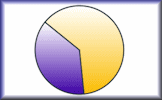
Develop the skills to construct and interpret pie charts in this self-marking set of exercises.
Averages
Test your understanding of averages with this self marking quiz about mean, median and range.
Histograms
Practise drawing and reading information from histograms displaying grouped data
Tally Charts
Read and draw simple tally charts to record and count different types of data.
Choose Your Average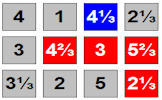
This is a game for two players. You should know how to find the mean, median and range of a set of numbers.
Estimating Correlation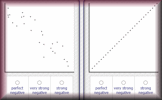
Practise the skill of estimating the correlation of data on a scatter graph in this self marking exercise.
Correlation
Arrange the given statements in groups to show the type of correlation they have.
Reading Graphs and Charts
Answer real-life problems from different types of graphs and charts including piece-wise linear graphs.
Mixed Medians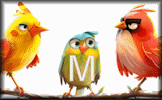
Find the medians of sets of different types of numbers in these self-marking exercises.
StatGrid Challenge
Arrange the numbers one to nine in a three by three grid to obtain the given means, medians and ranges.
Code Cracker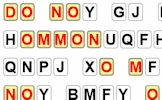
Crack the code by replacing the encrypted letters in the given text. There are lots of hints provided about code breaking techniques.
Cumulative Frequency
Online exercises on cumulative frequency for discrete and grouped data with exam-style questions.
Comparing Graphs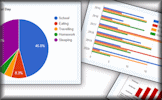
Would you recognise a misleading graph if you saw one? Try this comparative judgement exercise to rate statistical graphs.
Statistics Supplied
Find all of the sets of numbers matching the given statistical conditions.
Plotting Scatter Graphs
Plot scatter graphs from data representing a number of different everyday situations.
Quartiles
Practise processing the sets of numbers to find the lower and upper quartiles.
Box Plots
An exercise on reading and drawing box-and-whisker diagrams which represent statistical data.
Standard Deviation
Find how 'spread out' data is by estimating and calculating this measure of dispersion.
Odd Scatter Out
Just by looking at the scatter graphs can you decide which is the odd one out according to their summary statistics?
Reaction Time
When the numbers appear hit the correct button depending on whether the numbers are even or odd
First Impressions
This activity will collect data about your first impressions of some optical illusions. You can then analyse the data to come to your own conclusions.
This is the main Transum help video on Statistics.
Averages Video
Revise how to calculate the mean, median, mode and range from lists and frequency tables.
It's not hard (Averages song)
A really zany video revising mean, median, mode and range
Mean, Median and Mode Song
A free trial lesson from Math Upgrade dot com.
Tally Charts Video
A guided tour through the levels of the Tally Charts online exercise.
Scatter Graphs
Maths teachers from England construct a scatter graph from their heights and shoe sizes.
Visualising Data
Hans Rosling's famous lectures combine enormous quantities of public data with a sport's commentator's style to reveal the story of the world's past, present and future development.
Box Plots Video
Box plots, sometimes called box and whisker diagrams, are a useful way of visualising data.
Statistical Significance
This video explains numeric and categorical data and helps you gain an understanding of when to apply a t-test or a chi-square test.
A Show Of Hands
Produce a number of graphs and charts from a quick show of hands.
Pie Chart Creator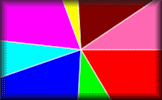
A quick and convenient tool for rapidly creating simple pie charts.
Correlation
Arrange the given statements in groups to show the type of correlation they have.
Human Scatter Graphs
Pupils move to positions in the room according to their data relative to the walls as axes.
Code Cracking Presentation
A slide presentation showing techniques for cracking simple codes and ciphers.
Centre and Variability
Make sense of and determine the reasonableness of the mean and median of a data set by looking at the values.
Comparing Graphs
Would you recognise a misleading graph if you saw one? Try this comparative judgement exercise to rate statistical graphs.
Normal Distribution Calculator
A customised online calculator for quickly finding areas under the normal distribution curve.
Significance
A slide presentation showing how to use the chi-squared test to measure significance.
Plinko Probability
A simulation of a Quincunx (Galton Board) which can be used to create the bell shaped curve of the normal distribution.
t-Test Revision
A slide presentation designed to revise the key aspects of Student's t-Test.
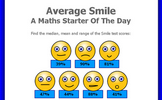
Average Smile
Calculate the mean, median and range of the given scores.

Choc Bar Chart
Interpret data given in the form of a bar chart then create a new bar chart showing the given statistics.

Pie Chart
An exercise in estimating what the sectors of a pie chart represent.

Weather Maths
Eight mathematical questions about the current weather and times in four cities around the world.
37 items are currently in this category.
Teachers might find the complete Statistics Topic List useful.
Statistics is the study of the collection, organisation, analysis, interpretation and presentation of data. It deals with all aspects of data, including the planning of data collection in terms of the design of surveys and experiments. It also includes describing mathematical relationships between variables and presenting these to an audience in a way that best conveys meaning.
See also the topics called Data Handling, Probability and Averages.